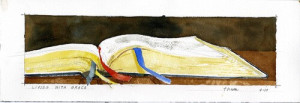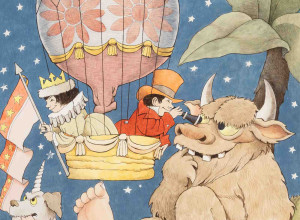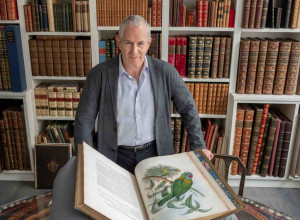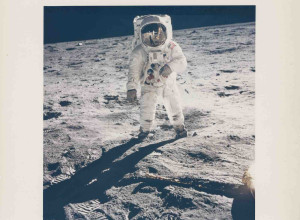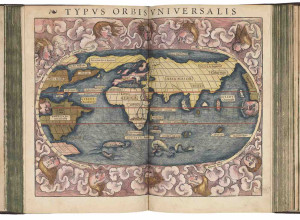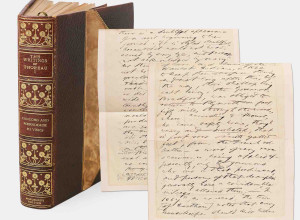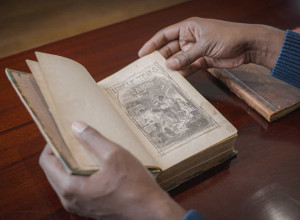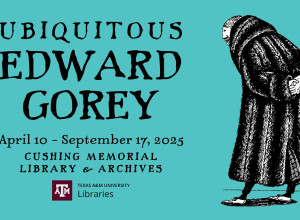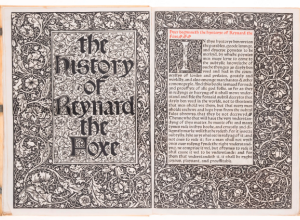Bright Young Librarians: Christine Jacobson
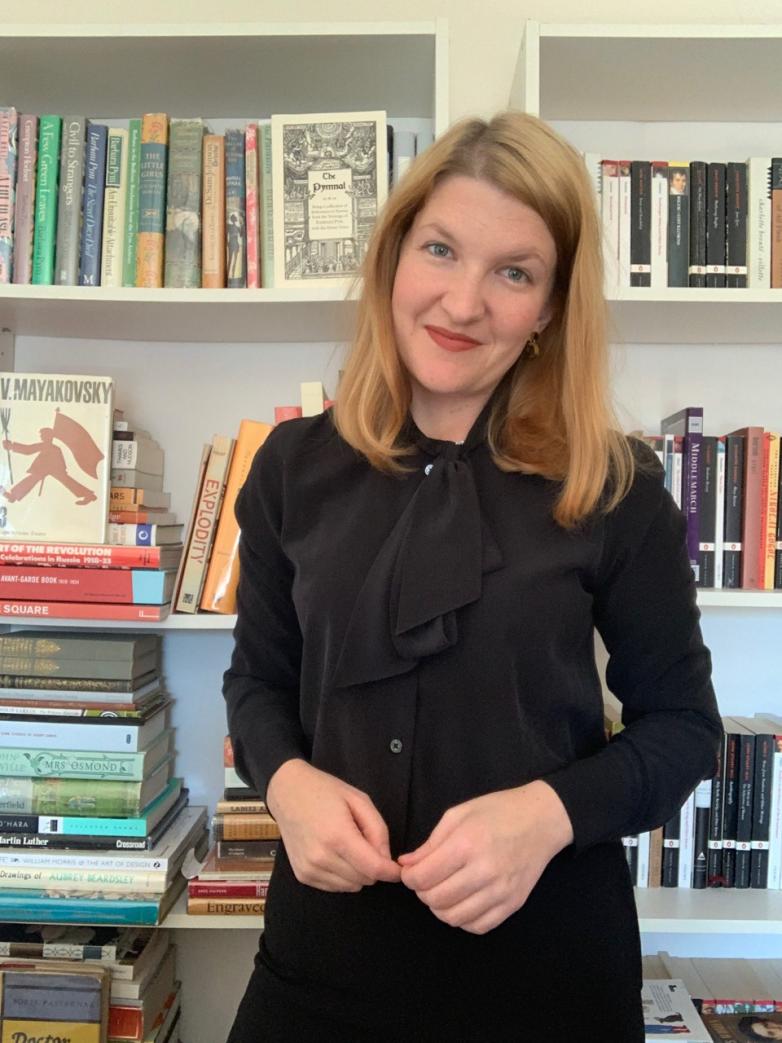
Our Bright Young Librarians series continues today with Christine Jacobson, Assistant Curator of Modern Books and Manuscripts at the Houghton Library at Harvard University in Cambridge, Massachusetts.
What is your role at your institution?
I am the Assistant Curator of Modern Books and Manuscripts. My main role is to help steward and develop the library’s collections from 1800 to present day, but I also provide advanced reference, teach classes, field copyright questions, host visiting groups, and curate exhibitions.
How did you get started in special collections?
While I was in graduate school doing an MA in Russian and Eurasian Studies, I took a part-time job working in the stacks at Houghton Library to help pay my rent. I struck up a friendship with an archivist there who eventually pulled me out of the stacks to help process a few Russian-language collections. I enjoyed the work immensely and soon took on more odd jobs with other campus libraries that had Russian-language special collections. By the time I finished my master's program, I knew I wanted to work in special collections full-time.
Where did you earn your MLS/advanced degree?
I hold a master's degree in Russian and Eurasian studies from Harvard University, and am nearly done with my MLIS from Simmons University, which I work on part-time and online.
Favorite rare book / ephemera that you've handled?
I imagine everyone struggles with this question and Houghton Library’s astonishing collections won’t help matters much. There is a book I return to repeatedly when I teach classes, and that is Vladimir Mayakovsky’s Dlia Golosa or “For the Voice.” It’s a beautifully made book of poems written by Mayakovsky and designed by the Russian artist El Lissitzky in 1923. Lissitzky designed the book to be read aloud to an audience (typically, in a smoky St. Petersburg café), which was a very important aspect of Mayakovsky’s work. To this end, each poem has a tab that depicts the poem’s title and a small illustration so that the reader can quickly thumb their way from one poem to another in any order. The poem's verses are also splayed out across the page, with certain words printed in bold or bright red to assist with dramatic readings. This book excites students in Russian literature classes, poetry classes, and graphic design classes and raises questions like, “what is the purpose of a book?” “how might a book like this have been printed in 1923?” and “what are the limitations of the traditional book?” Blessedly, MIT published an English-language facsimile in 2000 which I also keep handy for students who wish to understand the work in translation.
What do you personally collect?
I’m not a very studious or thorough collector, but I do have a large collection of catalogs for exhibitions held in the west on the Russian avant-garde movement. I not only love the 1910-1930 period in Russian art but am also fascinated by how different curators in Europe and America have approached such a complex and politically-motivated art movement over time.
I also collect modern firsts or simply well-designed editions of my favorite novels. I particularly love to own books by female writers with female illustrators or dust jacket designers, such as the Barbara Pym Dutton editions.
What do you like to do outside of work?
I live near several wonderful theaters that play classic Hollywood movies, foreign films, and independent cinema, and so my husband and I go to the movies at least one a week. I’ve also recently reconnected with music, which was a big part of my adolescence. It’s been a bit vulnerable and scary, but I’m taking drum and voice lessons and I absolutely love it. I’m hoping someone in Cambridge is searching for a Karen Carpenter to complete their band.
What excites you about special collections librarianship?
I was initially drawn to special collections for the opportunities to work with foreign-language materials. That aspect continues to excite me, but as a curator, I’m now more excited by this moment special collections librarianship finds itself in. First, I’m elated that our ideas about what has enduring research value are expanding to include material like tarot cards and tart cards, rrriot girl zines and graphic novels, Black Panther pamphlets and Marvel comics. I have been particularly inspired by my supervisor, Leslie Morris, who has worked hard to expand the traditional collecting boundaries of our department.
Secondly, I’m excited about the field’s devotion to accessibility. The other day I was going through a trove of internal library files related to a well-known collection of papers and I couldn’t believe how much paperwork was generated by old gatekeeping practices. I’m very proud to work at a library that no longer requires a letter of recommendation or an appointment, but rather, invites anyone with an interest in our collections to pull up a chair. My favorite moments at work are usually when a shy undergraduate asks me, “You mean I can touch this?” and I get to shout back at them gleefully, “Yes! That’s what it’s there for!”
The field still has some way to go in making everyone feel welcome in our spaces, but locally, I feel encouraged by the work my Houghton colleagues are doing to make our future renovated library building such a space: https://houghtonrenovation.library.harvard.edu/
Thoughts on the future of special collections librarianship?
I’m tempted to just link to my colleague John Overholt’s article Five Theses on the Future of Special Collections. (And in fact I will because it’s well worth reading.) In it, John argues for many things I endorse: enhanced access to digital collections through collaborative partnerships, fewer restrictions on our collections, user empowerment, transformative use of primary sources, and a field that not only advocates for itself but holds itself accountable to its users’ needs.
I want to add to this wish list that our field meaningfully address diversity in hiring, collection development, and partnerships. We are making strides in each of these areas, but too often we don’t go far enough. When PWIs hire librarians and archivists from historically marginalized communities, do they feel supported and safe at work? When PWIs collect material from historically marginalized communities, do we describe that material in a way that encourages members of those communities to use it? When PWIs engage in post-custodial partnerships with underfunded institutions, do they approach the work as charity or as solidarity? I think we have some work to do when it comes to answering these tough questions.
Fortunately, we have some amazing colleagues working to address these issues and I highly recommend seeking out work by April Hathcock, Dorothy Berry, and T-Kay Sangwand on these topics, respectively.
Any unusual or interesting collection at your library you'd like to draw our attention to?
I am currently reading Little Women and so I’m a little obsessed with our Louisa May Alcott collection. Houghton is home to Alcott’s manuscripts, correspondence, and diaries as well as the Alcott family papers and library. Though the manuscript for Little Women did not survive, Houghton holds many editions of the novel, including Sarah Orne Jewett’s copy of the first edition (!), as well as fun theatrical posters and ephemera from the novel’s many adaptations.
Any upcoming exhibitions at your library?
When Houghton Library reopens in the fall of 2020, we’ll celebrate with three exhibitions: one showcasing children’s literature in recognition of a major gift from the philanthropist and bibliophile Peter J. Solomon and his wife Susan, another on the poet John Keats to coincide with Bicentenary Keats Conference, and lastly, visitors to the library will also enjoy collections in a new exhibition space located in the library’s lobby.





